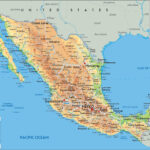Navigating the vibrant culinary landscape of Mexico can be an exciting adventure, especially for LGBTQ+ travelers seeking authentic experiences. At gaymexico.net, we believe that the best Mexican food is the food that connects you to culture and community, from traditional dishes to modern twists. This guide unveils the most delectable and iconic Mexican dishes, ensuring your culinary journey is as enriching as it is delicious. We’ll explore Mexican cuisine, LGBTQ+ travel, and Mexican culinary experiences.
1. Chilaquiles: A Breakfast Staple
Chilaquiles is undoubtedly a top contender for the best Mexican breakfast. This popular traditional breakfast dish features lightly fried corn tortillas cut into quarters and topped with either green or red salsa, with the red option packing a bit more heat. Scrambled or fried eggs and pulled chicken are frequently added on top, as well as cheese and cream. Chilaquiles are often served with a generous side of frijoles (refried beans).
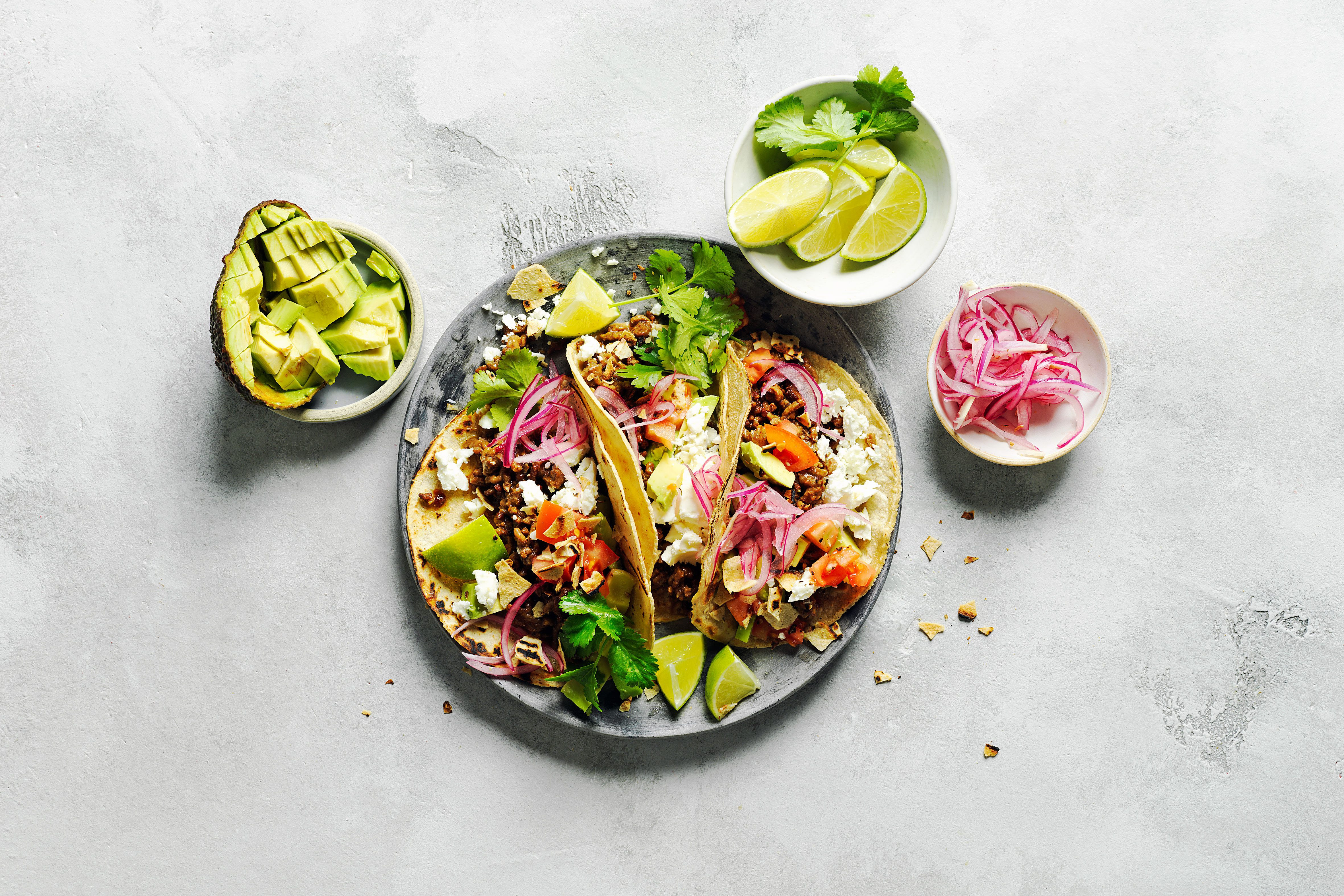 Chilaquiles with red sauce, eggs, and beans, a popular Mexican breakfast
Chilaquiles with red sauce, eggs, and beans, a popular Mexican breakfast
Why Chilaquiles Are a Must-Try
Chilaquiles offer a delightful combination of textures and flavors. The crispy tortillas, savory salsa, creamy toppings, and hearty beans create a satisfying and comforting meal, which will be the perfect way to start your day when you’re in Mexico. This dish is a testament to Mexican resourcefulness, transforming simple ingredients into a culinary masterpiece.
2. Pozole: A Hearty Soup with History
Pozole is another beloved Mexican dish with deep cultural roots. According to anthropologists, this pre-Hispanic soup was once used as part of ritual sacrifices. Today, chicken, pork, and vegetarian pozole versions are readily available in more everyday settings. This slow-cooked soup is made from hominy corn, herbs, and spices and traditionally stewed for hours, sometimes overnight. Before serving, it’s garnished with lettuce, radish, onion, lime, and chili.
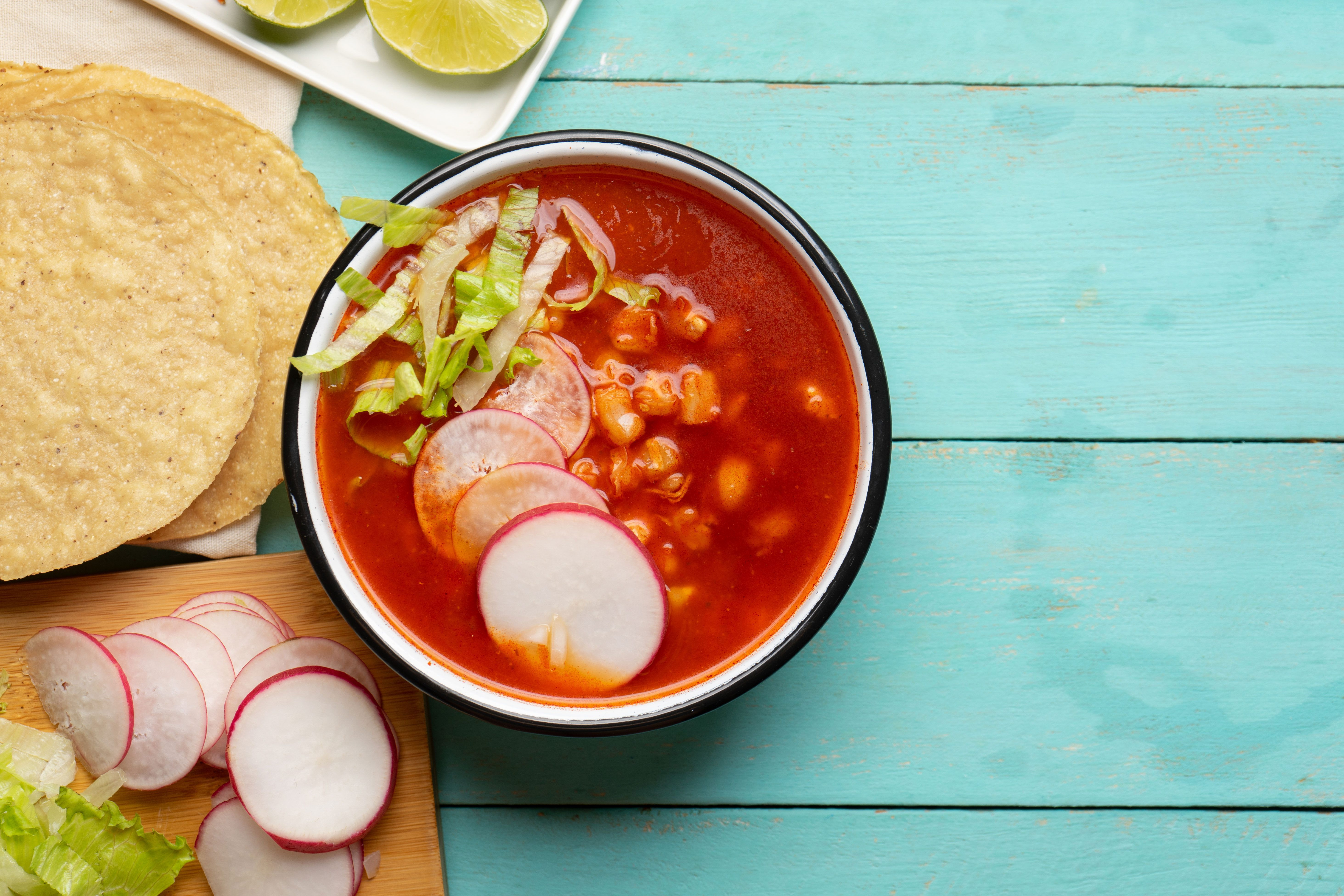 Red soup with beans, radishes and greens next to tortillas
Red soup with beans, radishes and greens next to tortillas
The Cultural Significance of Pozole
Pozole’s history is as rich as its flavor, originally holding a sacred place in ancient rituals. Today, it’s a symbol of Mexican culinary heritage, adapted with various proteins and vegetarian options to suit modern tastes. The dish’s communal nature, often shared during celebrations, makes it a perfect introduction to Mexican hospitality.
3. Tacos Al Pastor: A Fusion of Flavors
Tacos al pastor is an iconic Mexican street food with a fascinating history. This historic dish is one of the most popular varieties of tacos, with origins dating back to the 1920s and 30s and the arrival of Lebanese and Syrian immigrants to Mexico. To create tacos al pastor (meaning ‘in the style of the shepherd’), thin strips of pork are sliced off a spit, placed on a corn tortilla, and served with onions, coriander leaves, and pineapple.
The Unique Appeal of Tacos Al Pastor
The fusion of Middle Eastern and Mexican culinary traditions makes tacos al pastor a truly unique experience. The marinated pork, slow-cooked on a vertical spit, is incredibly flavorful, and the addition of pineapple adds a touch of sweetness that perfectly complements the savory meat.
4. Tostadas: Crispy and Versatile
Tostadas are a simple yet satisfying Mexican dish with endless possibilities. What should you do with stale tortillas? Why, fry them of course! Literally meaning toasted, tostadas are a simple but delicious dish involving corn tortillas fried in boiling oil until they become crunchy and golden. These are then served alone or piled high with any number of garnishes. Popular toppings include frijoles (refried beans), cheese, cooked meat, seafood, and ceviche.
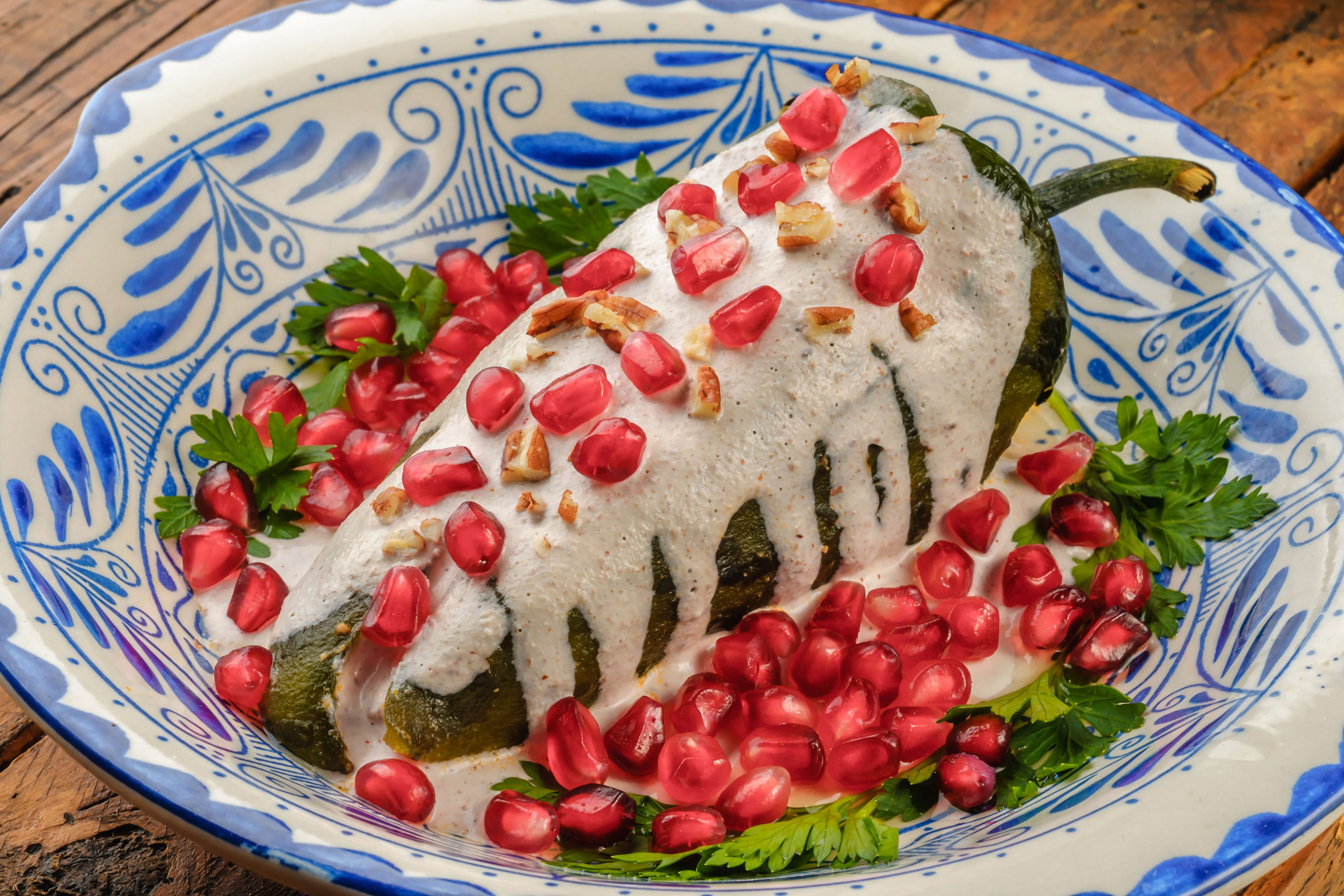 Summer veg tostadas with various toppings
Summer veg tostadas with various toppings
Why Tostadas Are a Great Choice
Tostadas are a blank canvas for culinary creativity. Their crispy texture and mild flavor make them the perfect base for a wide variety of toppings, from simple beans and cheese to elaborate seafood creations. This versatility makes tostadas a crowd-pleaser and a great option for those with dietary restrictions.
5. Chiles En Nogada: A Patriotic Dish
Chiles en nogada is a visually stunning and historically significant Mexican dish. Boasting the three colors of the Mexican flag, chiles en nogada is one of Mexico’s most patriotic dishes. Poblano chilies filled with picadillo (a mixture of chopped meat, fruits, and spices) represent the green on the flag, the walnut-based cream sauce is the white, and pomegranate seeds are the red. Originating from Puebla, history relates that the dish was first served to Don Agustín de Iturbide, liberator and subsequent emperor of Mexico.
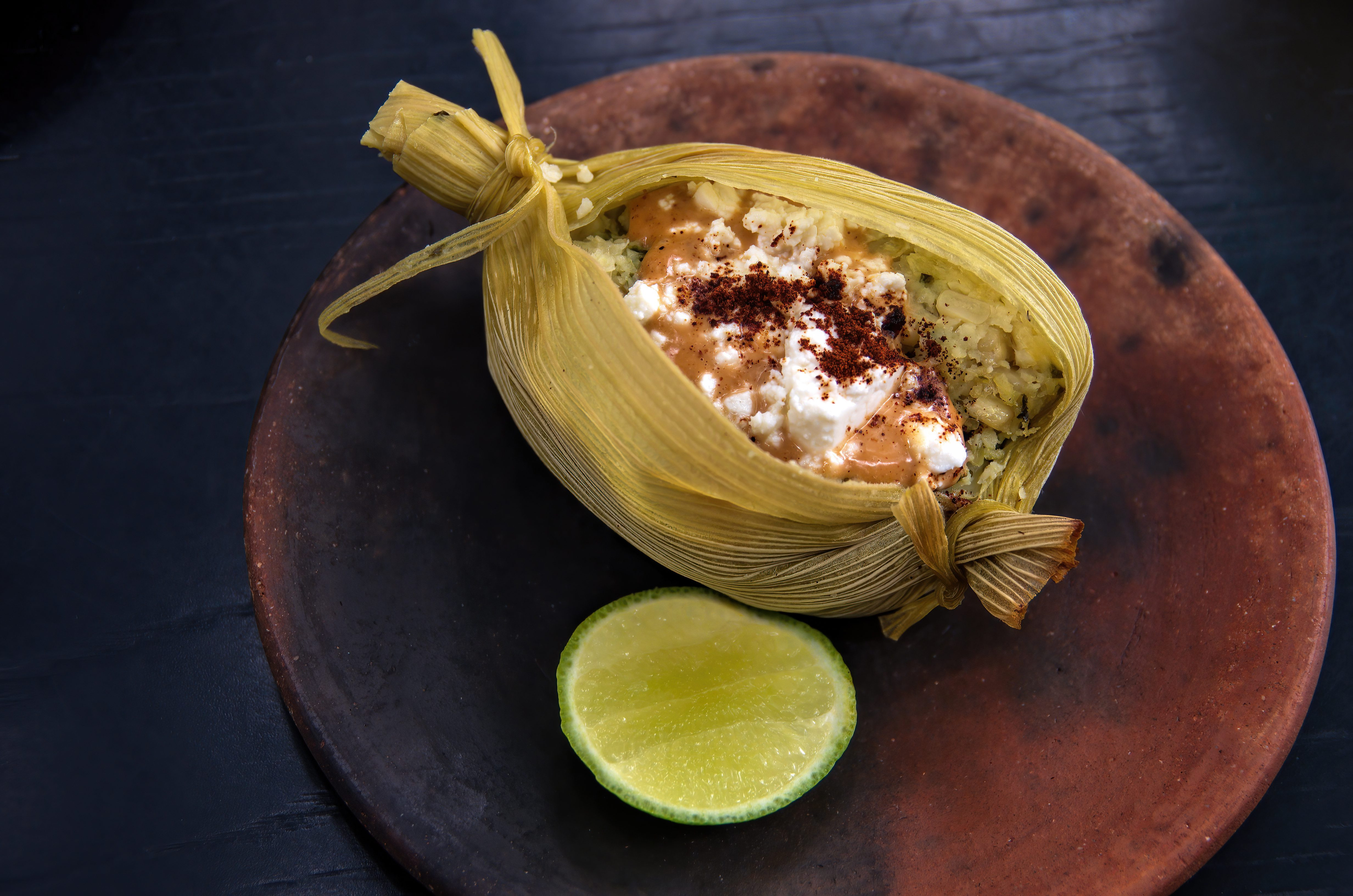 Chilli in a white sauce with pomegranate seeds
Chilli in a white sauce with pomegranate seeds
The Story Behind Chiles En Nogada
Chiles en nogada is more than just a delicious meal; it’s a symbol of Mexican independence and culinary artistry. The dish’s complex flavors and meticulous preparation reflect the country’s rich history and cultural pride. Served primarily during the months of August and September, when pomegranates are in season, chiles en nogada is a seasonal delight not to be missed.
6. Elote: Mexican Street Corn
Elote is a quintessential Mexican street food that’s both simple and incredibly satisfying. You’ll find someone selling elote, the Mexican name for corn on the cob, on nearly every city street corner in Mexico. The corn is traditionally boiled and served either on a stick (to be eaten like an ice cream) or in cups, the kernels having been cut off the cob. Salt, chili powder, lime, butter, cheese, mayonnaise, and sour cream are then added in abundance.
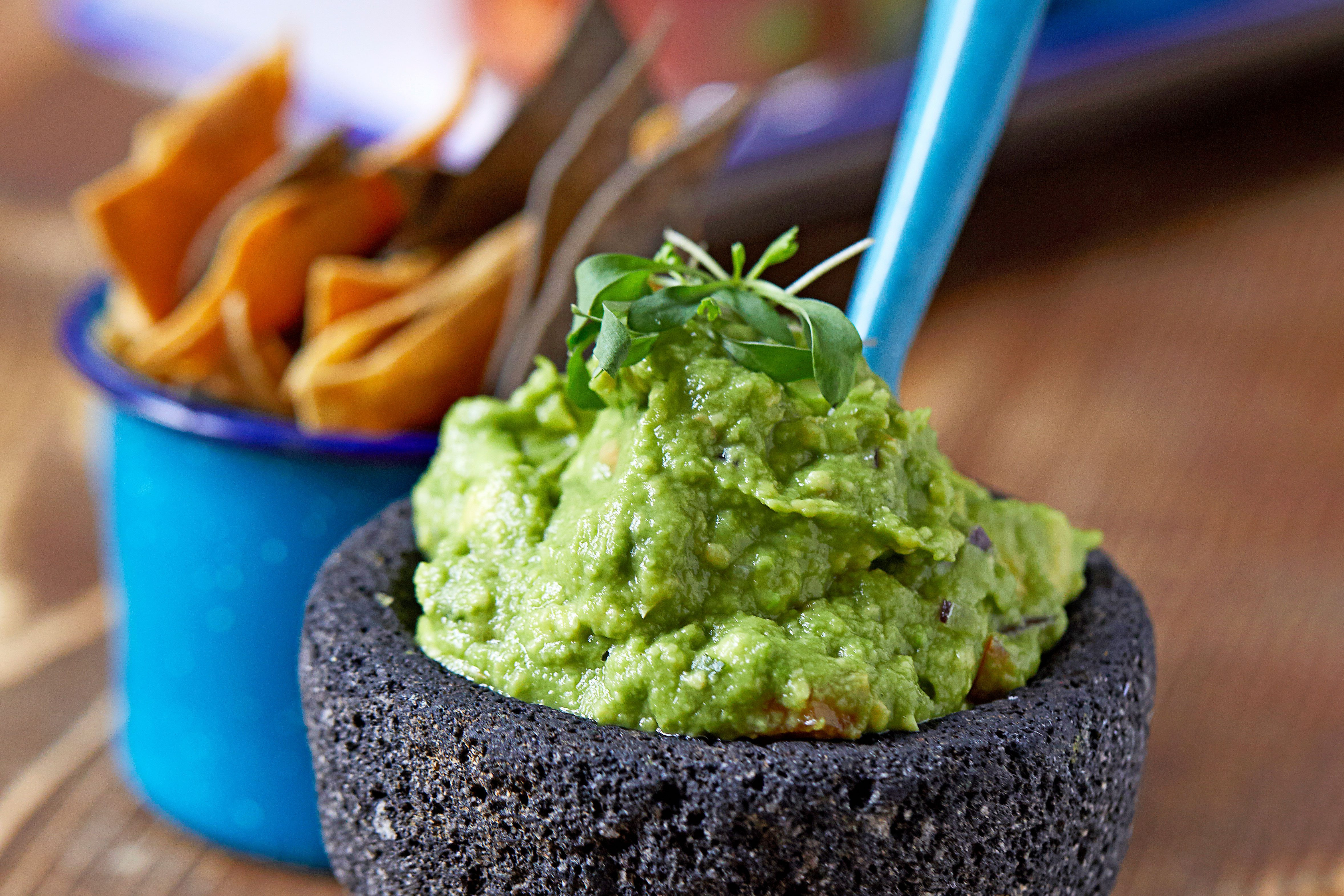 Grilled corn with chilli mayonnaise, coriander & feta
Grilled corn with chilli mayonnaise, coriander & feta
Why Elote Is a Street Food Favorite
Elote’s irresistible combination of sweet corn, tangy lime, spicy chili, and creamy toppings makes it a street food sensation. The dish is customizable to individual preferences, with vendors offering a variety of toppings and spice levels. Eating elote is a fun and social experience, often enjoyed with friends and family while strolling through Mexican cities.
7. Enchiladas: A Versatile Classic
Enchiladas are a versatile and comforting Mexican dish with ancient roots. Enchiladas date back to Mayan times, when people in the Valley of Mexico would eat corn tortillas wrapped around small fish. These days both corn and flour tortillas are used and are filled with meat, cheese, seafood, beans, vegetables or all of the above. The stuffed tortillas are then covered in a chili sauce, making for a perfect Mexican breakfast.
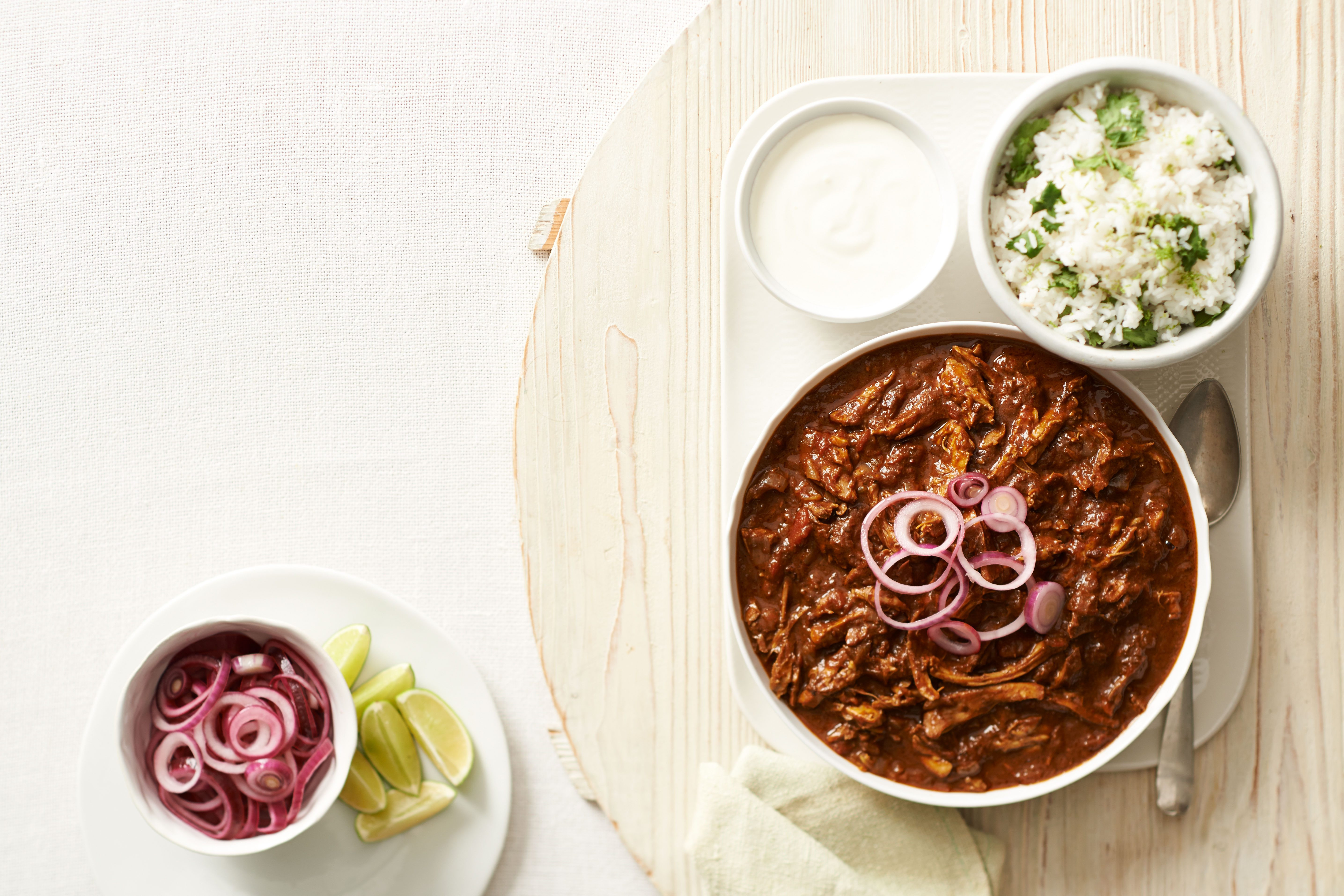 Dish of enchiladas with chicken and beans
Dish of enchiladas with chicken and beans
The Enduring Appeal of Enchiladas
Enchiladas offer endless possibilities for fillings and sauces, making them a versatile choice for any palate. Whether you prefer a classic cheese enchilada with red sauce or a more adventurous version with seafood and green sauce, there’s an enchilada out there for you. The dish’s comforting flavors and customizable nature make it a staple in Mexican cuisine.
8. Mole: A Complex Sauce
Mole (pronounced ‘mol-eh’) is a rich and complex sauce that’s a cornerstone of Mexican cuisine. Three states claim to be the original home of mole, a rich sauce popular in Mexican cooking. There are myriad types of mole but all contain around 20 or so ingredients, including one or more varieties of chili peppers, and all require constant stirring over a long period of time. Perhaps the best-known mole is mole poblano, a rusty red sauce typically served over turkey or chicken.
 Chicken mole with coriander rice
Chicken mole with coriander rice
The Art of Making Mole
Mole is a testament to Mexican culinary skill and patience. The sauce’s complex flavor profile is achieved through a painstaking process of roasting, grinding, and simmering a variety of ingredients, including chilies, spices, nuts, and chocolate. Making mole is often a family affair, with recipes passed down through generations.
9. Guacamole: The Perfect Dip
Guacamole is undoubtedly one of Mexico’s most popular dishes, but few people know that this traditional sauce dates back to the time of the Aztecs. Made from mashed-up avocados, onions, tomatoes, lemon juice and chilli peppers (and sometimes a clove or two of garlic), guacamole is often eaten with tortilla chips or used as a side dish.
Why Guacamole Is a Must-Have
Guacamole’s creamy texture, fresh flavors, and nutritional benefits make it a crowd-pleasing dip and a healthy addition to any meal. The dish is easy to customize with different levels of spice and variations in ingredients, allowing you to create your perfect guacamole. Enjoy it with tortilla chips, as a topping for tacos or tostadas, or as a side dish with grilled meats or vegetables.
10. Tamales: A Portable Feast
Tamales were first developed for the Aztec, Mayan and Inca tribes who needed nourishing food on the go to take into battle. Pockets of corn dough are stuffed with either a sweet or savory filling, wrapped in banana leaves or corn husks, then steamed. Fillings vary from meats and cheeses to fruits, vegetables, chillies and mole. Remember to discard the wrapping before eating.
 Red soup with beans, radishes and greens next to tortillas
Red soup with beans, radishes and greens next to tortillas
The Convenience and Variety of Tamales
Tamales are a portable and versatile Mexican dish that’s perfect for a quick meal or a festive gathering. The dish’s fillings can range from savory meats and cheeses to sweet fruits and spices, offering a variety of flavors to suit any taste. Making tamales is a labor of love, often done in large batches during holidays and special occasions.
Exploring LGBTQ+ Friendly Culinary Hotspots in Mexico
Mexico is increasingly recognized for its LGBTQ+ inclusivity, with several cities leading the way in offering welcoming spaces and experiences.
Mexico City: Mexico City has a vibrant gay scene, particularly in neighborhoods like Zona Rosa. Many restaurants and cafes in this area are LGBTQ+ friendly and offer a diverse range of culinary experiences, from traditional Mexican cuisine to international flavors.
Puerto Vallarta: Puerto Vallarta is known as one of the most gay-friendly destinations in Mexico. The Romantic Zone is the heart of the gay scene, featuring numerous restaurants, bars, and clubs that cater to the LGBTQ+ community. Here, you can enjoy everything from beachfront dining to upscale culinary experiences.
Guadalajara: Guadalajara is becoming increasingly popular among LGBTQ+ travelers. The city offers a mix of traditional and modern Mexican culture, with a growing number of gay-friendly establishments. Key areas include Chapultepec and Colonia Americana, where you can find a variety of dining options and cultural experiences.
San Miguel de Allende: San Miguel de Allende, known for its colonial architecture and vibrant arts scene, is also gaining recognition for its inclusivity. The city boasts numerous restaurants and cafes with welcoming atmospheres, offering both traditional Mexican dishes and international cuisine.
Cancun: While primarily known for its beaches and resorts, Cancun also has a growing LGBTQ+ scene. Many hotels and restaurants in the Hotel Zone are LGBTQ+ friendly, and you can find specific gay bars and clubs in the downtown area.
Table: LGBTQ+ Friendly Cities in Mexico
| City | LGBTQ+ Scene | Culinary Highlights |
|---|---|---|
| Mexico City | Vibrant, Zona Rosa | Diverse, traditional to international |
| Puerto Vallarta | Thriving, Romantic Zone | Beachfront dining, upscale experiences |
| Guadalajara | Growing, Chapultepec | Mix of traditional and modern, varied dining options |
| San Miguel de Allende | Welcoming, Central | Traditional Mexican and international cuisine |
| Cancun | Developing, Hotel Zone | Hotels and restaurants, gay bars and clubs |
Must-Try Mexican Dishes by Region
Mexican cuisine varies significantly by region, each offering unique flavors and ingredients.
Oaxaca: Known for its complex mole sauces, tlayudas (large, crispy tortillas topped with various ingredients), and mezcal.
Puebla: Famous for chiles en nogada, mole poblano, and cemitas (stuffed sandwiches).
Yucatán: Renowned for cochinita pibil (slow-roasted pork), sopa de lima (lime soup), and panuchos (stuffed tortillas).
Baja California: Celebrated for its fresh seafood, fish tacos, and Baja Med cuisine, a fusion of Mexican, Mediterranean, and Asian flavors.
Guadalajara: Known for birria (a spicy goat stew), tortas ahogadas (drowned sandwiches), and tejuino (a fermented corn beverage).
Table: Regional Mexican Cuisine
| Region | Signature Dishes | Key Ingredients |
|---|---|---|
| Oaxaca | Mole, Tlayudas, Mezcal | Chilies, chocolate, corn, agave |
| Puebla | Chiles en Nogada, Mole Poblano, Cemitas | Poblano peppers, walnuts, pomegranate, sesame seeds |
| Yucatán | Cochinita Pibil, Sopa de Lima, Panuchos | Pork, lime, achiote, habanero peppers |
| Baja California | Fish Tacos, Baja Med Cuisine | Seafood, olive oil, vegetables, Asian spices |
| Guadalajara | Birria, Tortas Ahogadas, Tejuino | Goat, bread, chilies, corn |
Finding Authentic Mexican Food
To truly experience the best Mexican food, venture beyond touristy areas and explore local markets, street food stalls, and family-run restaurants.
Local Markets (Mercados): Markets like Mercado Medellín in Mexico City offer a wide array of regional dishes and fresh ingredients.
Street Food Stalls (Puestos Callejeros): Look for busy stalls with long lines, a sign of delicious and authentic food.
Family-Run Restaurants (Fondas): These small, often humble establishments serve home-style cooking passed down through generations.
Tips for an Authentic Culinary Experience
- Ask Locals: Locals can provide the best recommendations for hidden culinary gems.
- Be Adventurous: Don’t be afraid to try new and unfamiliar dishes.
- Learn Some Spanish: Knowing basic Spanish phrases will enhance your interactions with vendors and restaurant staff.
- Check Reviews: Look for online reviews from locals and food critics.
The Role of Food in Mexican Culture and LGBTQ+ Community
Food is an integral part of Mexican culture, representing tradition, family, and community. For the LGBTQ+ community, sharing meals can be a powerful way to connect with their heritage and build bonds with fellow travelers and locals.
Community and Connection: Food brings people together, providing a sense of belonging and shared experience.
Cultural Preservation: Traditional dishes are passed down through generations, preserving cultural identity and heritage.
Celebration and Festivity: Food plays a central role in Mexican celebrations, from Día de Muertos to Christmas.
How Food Can Enhance Your LGBTQ+ Travel Experience
- Explore LGBTQ+ Owned Restaurants: Support LGBTQ+ entrepreneurs and enjoy delicious meals in welcoming environments.
- Attend Culinary Events: Participate in food festivals and cooking classes to learn about Mexican cuisine and meet new people.
- Share Meals with Locals: Invite local LGBTQ+ individuals to share a meal and learn about their experiences and perspectives.
Navigating Dietary Restrictions and Preferences
Mexico offers a variety of options for those with dietary restrictions or preferences.
Vegetarian and Vegan Options: While traditional Mexican cuisine often includes meat, vegetarian and vegan options are increasingly available. Look for dishes made with beans, vegetables, and tofu.
Gluten-Free Options: Corn tortillas are naturally gluten-free, making many Mexican dishes suitable for those with gluten sensitivities.
Allergies: Be sure to communicate any allergies to restaurant staff, as some dishes may contain nuts, dairy, or other allergens.
Useful Phrases for Dietary Needs
- “Soy vegetariano/a.” (I am vegetarian.)
- “Soy vegano/a.” (I am vegan.)
- “Soy alérgico/a a…” (I am allergic to…)
- “¿Tiene opciones sin gluten?” (Do you have gluten-free options?)
Top 5 Mexican Drinks to Try
No culinary journey through Mexico is complete without sampling the local beverages.
- Margarita: A classic cocktail made with tequila, lime juice, and orange liqueur.
- Michelada: A savory beer cocktail with lime juice, hot sauce, and spices.
- Agua Fresca: A refreshing drink made with fruit, water, and sugar.
- Mezcal: A distilled spirit made from agave, similar to tequila but with a smoky flavor.
- Horchata: A sweet rice milk drink flavored with cinnamon and vanilla.
Table: Must-Try Mexican Drinks
| Drink | Description | Key Ingredients |
|---|---|---|
| Margarita | Tequila-based cocktail | Tequila, lime juice, orange liqueur |
| Michelada | Savory beer cocktail | Beer, lime juice, hot sauce, spices |
| Agua Fresca | Refreshing fruit drink | Fruit, water, sugar |
| Mezcal | Distilled agave spirit | Agave |
| Horchata | Sweet rice milk drink | Rice, cinnamon, vanilla |
Essential Mexican Pantry Staples
To recreate the flavors of Mexico at home, stock up on these essential pantry staples.
- Dried Chilies: Ancho, guajillo, and pasilla chilies are used to make a variety of sauces and stews.
- Corn Tortillas: A staple of Mexican cuisine, used for tacos, enchiladas, and tostadas.
- Beans: Black, pinto, and kidney beans are used in soups, stews, and side dishes.
- Rice: Long-grain white rice is often served as a side dish.
- Spices: Cumin, oregano, cinnamon, and cloves are commonly used in Mexican cooking.
Where to Buy Authentic Ingredients
- Latin American Grocery Stores: These stores typically carry a wide variety of Mexican ingredients.
- Online Retailers: Websites like Amazon and MexGrocer.com offer a range of authentic Mexican products.
- Specialty Food Stores: Stores specializing in international foods may carry some Mexican ingredients.
Understanding Mexican Dining Etiquette
Understanding Mexican dining etiquette will help you navigate the culinary scene with confidence.
- Tipping: It is customary to tip 10-15% in restaurants.
- Utensils: Mexicans typically use a fork and knife for most meals.
- Sharing: Sharing dishes is common, especially among friends and family.
- Respect: Show respect for the food and the people who prepared it.
Useful Phrases for Dining Out
- “La cuenta, por favor.” (The bill, please.)
- “¿Me puede traer…?” (Can you bring me…?)
- “Está delicioso/a.” (It’s delicious.)
- “Muchas gracias.” (Thank you very much.)
Safety Tips for LGBTQ+ Travelers in Mexico
While Mexico is generally becoming more accepting of LGBTQ+ individuals, it’s essential to take certain precautions to ensure your safety and well-being.
- Research: Research LGBTQ+ friendly areas and establishments in advance.
- Stay Informed: Be aware of local laws and customs.
- Be Discreet: Avoid public displays of affection in more conservative areas.
- Trust Your Instincts: If you feel uncomfortable in a situation, leave.
- Stay Connected: Keep in touch with friends and family and share your travel itinerary.
Resources for LGBTQ+ Travelers
- GayMexico.net: Offers travel guides, event listings, and community resources for LGBTQ+ travelers in Mexico.
Address: 3255 Wilshire Blvd, Los Angeles, CA 90010, United States
Phone: +1 (213) 380-2177
Website: gaymexico.net - The International LGBTQ+ Travel Association (IGLTA): Provides resources and information for LGBTQ+ travelers worldwide.
- Human Rights Watch: Offers reports and information on LGBTQ+ rights in Mexico.
Conclusion: A Culinary Journey for Every Palate
The best Mexican food is a matter of personal taste, but the dishes highlighted in this guide offer a delicious starting point for your culinary exploration. Whether you’re an LGBTQ+ traveler seeking authentic experiences or a food lover looking to expand your palate, Mexico has something to offer everyone. Remember to visit gaymexico.net for more tips, guides, and resources to enhance your travel experience. Explore the vibrant culinary scene, connect with local culture, and create unforgettable memories in this beautiful and welcoming country.
Ready to embark on your culinary adventure? Visit gaymexico.net to discover more LGBTQ+-friendly travel guides, event listings, and community resources in Mexico. Start planning your trip today and experience the best of Mexican cuisine!
FAQ: Frequently Asked Questions About Mexican Food
1. What is the most popular Mexican dish?
Tacos are arguably the most popular Mexican dish, enjoyed worldwide for their versatility and flavor. They are a staple street food, available with various fillings to suit any taste.
2. What is the difference between enchiladas and tacos?
Enchiladas are tortillas filled and covered in sauce, while tacos are typically smaller tortillas filled with various ingredients and served without sauce on top.
3. What is mole sauce made of?
Mole sauce is made from a complex blend of chilies, spices, nuts, chocolate, and other ingredients, simmered for a long period to create a rich and flavorful sauce.
4. Is Mexican food spicy?
While some Mexican dishes are spicy, not all of them are. Many dishes can be customized to your preferred spice level.
5. What is the best Mexican street food?
Elote (Mexican street corn) and tacos al pastor are popular choices for Mexican street food, offering a delicious and authentic culinary experience.
6. What are some vegetarian Mexican dishes?
Vegetarian Mexican dishes include bean burritos, cheese enchiladas, guacamole, and vegetable-filled quesadillas.
7. What is the significance of corn in Mexican cuisine?
Corn is a staple ingredient in Mexican cuisine, used to make tortillas, tamales, and many other dishes. It holds cultural and historical significance in Mexico.
8. What is a good Mexican breakfast?
Chilaquiles and huevos rancheros are popular choices for a traditional Mexican breakfast, offering a hearty and flavorful start to the day.
9. How can I find authentic Mexican food in the US?
Look for local Mexican restaurants and food trucks with positive reviews from locals. Check online reviews and ask for recommendations.
10. Are there any regional differences in Mexican food?
Yes, Mexican cuisine varies significantly by region, each offering unique flavors and ingredients. Oaxaca is known for its mole sauces, while the Yucatán is famous for cochinita pibil.
